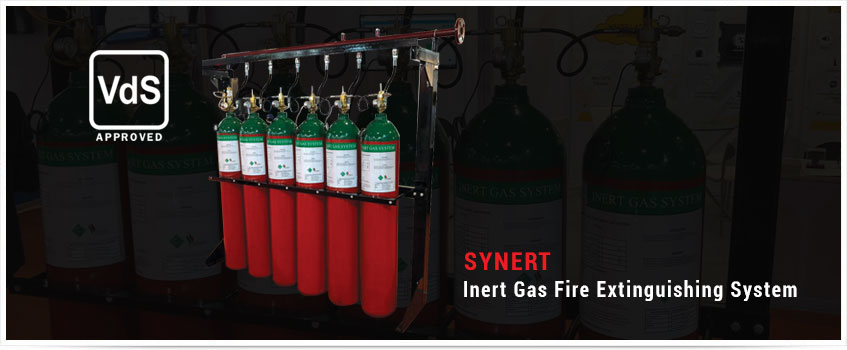
Introduction
SYNERT 200 Bar / 300 Bar Inert Gas System
SYNERT GAS SYSTEM is the safe, natural way to extinguish a fire.
SYNERT GAS SYSTEM is safer and more economical than any other system on the market.
SYNERT Gas System : The Latest Technology
SWASTIK SYNERGY has introduced an improvement in systems using IG-01,IG-55,IG-100,IG-541 as the extinguishing agent with the latest technology, providing benefits to the facility itself and the protected enclosure.
This innovative technology enables to optimize the design of the firefighting system with IG-01,IG-55,IG-100,IG-541 as the discharge pressure and flow control allow users to reduce the size of tubing needed for proper distribution of the agent and reduce overpressure that take place in the protected enclosure, minimizing the area for the relief of excess pressure.
SYNERT systems are designed to suppress fires involving class A, B and C hazards. The systems are designed to be total flooding and consist of a fixed supply of agent connected to a piping system with nozzles to direct the agent into an enclosed hazard. Inert gas extinguishes fires by lowering the oxygen content below the level that supports combustion. In simple terms if the oxygen content of the atmosphere is reduced to a level below 15%, most ordinary combustibles will not burn. Since SYNERT agents are stored as a gas, it discharges as an invisible gas, allowing people to safely exit a protected space without obscured vision.
SYNERT gas systems are particularly valuable in extinguishing fires in enclosures containing hazards or equipment where a clean, electrically non-conductive medium is essential or where the cleaning up of foam, water or powder would be problematic. An inert gas fire suppression system guarantees effective fire control without endangering infrastructure or delicate equipment.
SYNERT GAS SYSTEM containers allow you to protect single- or multiple-hazard areas typically requiring less floor space than other inert gas systems
Think of the cost savings!
You no longer need to purchase, install and maintain several individual protection systems for your multi-risk facility. One SYNERT GAS SYSTEM does it all.
Temperature Range :
The components are designed and tested to operate in the temperature range -20 °C to 50 °C or as stated in separate component listings.
SYNERT Agents :
Under normal conditions SYNERT agents is an odourless and colourless gas.
SYNERT Gases do not support combustion, nor have an impact on the ozone layer, and has no global warming potential. Inert Gases are supplied as under :
| Name of Gas | Contents |
| SYNERT IG-01 | Argon |
| SYNERT IG-55 | 50% Argon, 50% Nitrogen |
| SYNERT IG-100 | Nitrogen |
| SYNERT IG-541 | 52% Nitrogen, 40% Argon, 8% CO2 |
Storage containers are designed to hold agent in gaseous form at a nominal pressure of 200 bar or 300 bar at 15 °C.
Handling and Installation of SYNERT equipment should only be carried out by persons experienced in dealing with this type of equipment. The following specification applies to SYNERT agents.
| Pressure (300 Bar System) | 295 Bar – 300 Bar at 15° C |
| Pressure (200 Bar System) | 195 Bar – 200 Bar at 15° C |
| Moisture | Max 12 ppm |
The extinguishing principle of inert gases focuses on reducing oxygen concentration in the affected zone. When a fire starts SYNERT Gases rapidly penetrates the area and reduces the oxygen level percentage from the usual level of 21% to a limit that fluctuates between 13% and 11%, the amount sufficient for combustion to stop and to be safe for the people in the room. Due to the stratification of the gases, protection is achieved throughout the space, regardless of how high the ceiling is. During its discharge, there is excellent visibility and, since it leaves no residue, there are no destructive effects to the equipment, which will continue functioning normally and, of course, there will be nothing to clean up.
| Pressure | Container Size |
| 200 Bar | 68 Litre |
| 200 Bar | 80 Litre |
| 200 Bar | 100 Litre |
| 200 Bar | 120 Litre |
| 200 Bar | 140 Litre |
| 300 Bar | 68 Litre |
| 300 Bar | 80 Litre |
| 300 Bar | 100 Litre |
| 300 Bar | 120 Litre |
| 300 Bar | 140 Litre |
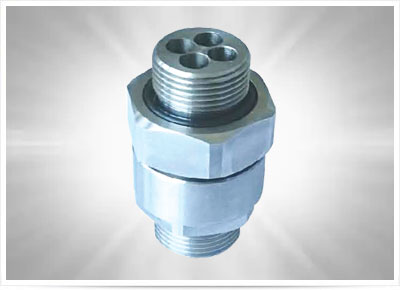
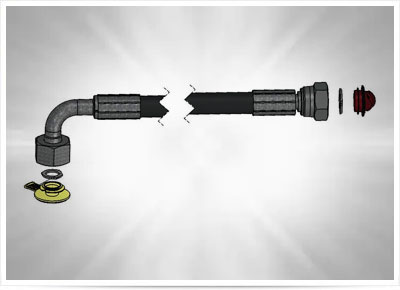
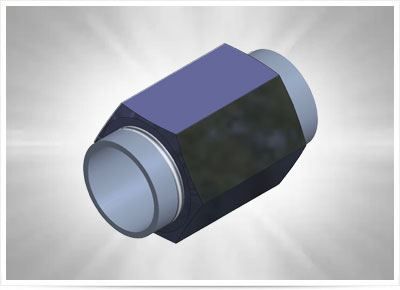
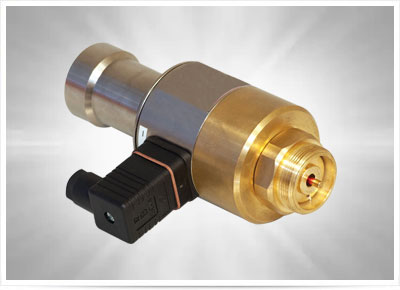
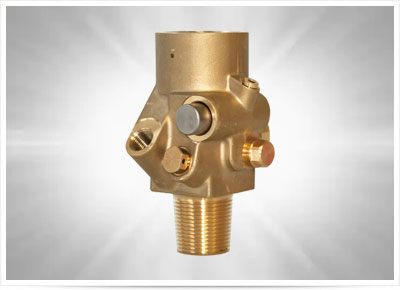

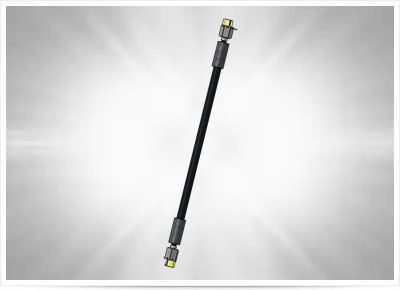
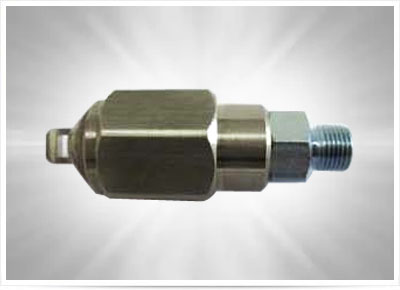
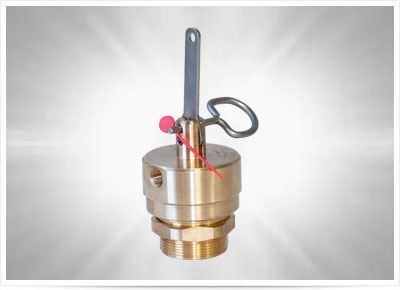
- Environmentally friendly gas, extracted directly from the atmosphere.
- Unquestionable environmental benefits (zero ODP and GWP).
- Clean and free of residues, allowing immediate return to business.
- Total availability worldwide, without brand restrictions.
- Cost-effective, stable and easy to refill.
- Allows for long and complex pipe runs.
- Comprehensive Advice Every Stage.
- Unbeatable ability to flood the entire protected enclosure
- Multipurpose : Very widespread use as an extinguishing agent
- Safe Evacuation of Personnel : Good visibility, No Risk design concentration
- Gas mixture possesses a density similar to air.
Physical Properties of IG-01
| Property | Unit | Value |
| Molecular mass | - | 39.9 |
| Boiling point at 1.013 bar (absolute) ᵃ | °C | -185.9 |
| Freezing point | °C | -189.4 |
| Critical temperature | °C | -122.3 |
| Critical pressure | bar abs ᵃ | 49.0 |
| Critical volume | cmᵌ/mol | - |
| Critical density | kg/mᵌ | 536 |
| Vapour pressure 20 °C | bar abs ᵃ | - |
| Liquid density 20 °C | kg/mᵌ | - |
| Saturated vapour density 20 °C | kg/mᵌ | - |
| Specific volume of superheated vapour at 1.013 bar and 20 °C | mᵌ/kg | 0.602 |
| Chemical formula | Ar | |
| Chemical name | Argon | |
| ᵃ 1 bar = 0.1 MPa = 10⁵ Pa; 1 MPa = 1 N/mm² | ||
Physical Properties of IG-55
| Property | Unit | Value |
| Molecular mass | - | 33.98 |
| Boiling point at 1.013 bar (absolute) ᵃ | °C | - |
| Freezing point | °C | - |
| Critical temperature | °C | - |
| Critical pressure | bar abs ᵃ | - |
| Critical volume | cmᵌ/mol | - |
| Critical density | Kg/mᵌ | - |
| Vapour pressure 20 °C | bar abs ᵃ | - |
| Liquid density 20 °C | Kg/mᵌ | - |
| Saturated vapour density 20 °C | Kg/mᵌ | - |
| Specific volume of superheated vapour at 1.013 bar and 20 °C | mᵌ/kg | 0.708 |
| Chemical formulas | N₂ 50% by volume Ar 50% by volume |
|
| Chemical names | Nitrogen Argon |
|
| ᵃ 1 bar = 0.1 MPa = 10⁵ Pa; 1 MPa = 1 N/mm² | ||
Physical Properties of IG-100
| Property | Unit | Value |
| Molecular mass | - | 39.9 |
| Boiling point at 1.013 bar (absolute) ᵃ | °C | -185.9 |
| Freezing point | °C | -189.4 |
| Critical temperature | °C | -122.3 |
| Critical pressure | bar abs ᵃ | 49.0 |
| Critical volume | cmᵌ/mol | - |
| Critical density | kg/mᵌ | 536 |
| Vapour pressure 20 °C | bar abs ᵃ | - |
| Liquid density 20 °C | kg/mᵌ | - |
| Saturated vapour density 20 °C | kg/mᵌ | - |
| Specific volume of superheated vapour at 1.013 bar and 20 °C | mᵌ/kg | 0.602 |
| Chemical formula | N₂ | |
| Chemical name | Nitrogen | |
| ᵃ 1 bar = 0.1 MPa = 10⁵ Pa; 1 MPa = 1 N/mm² | ||
Physical Properties of IG-541
| Property | Unit | Value |
| Molecular mass | - | 33.98 |
| Boiling point at 1,013 bar (absolute) ᵃ | °C | - |
| Freezing point | °C | - |
| Critical temperature | °C | - |
| Critical pressure | bar abs ᵃ | - |
| Critical volume | cmᵌ/mol | - |
| Critical density | kg/mᵌ | - |
| Vapour pressure 20 °C | bar abs ᵃ | - |
| Liquid density 20 °C | kg/mᵌ | - |
| Saturated vapour density 20 °C | kg/mᵌ | - |
| Specific volume of superheated vapour at 1,013 bar and 20 °C | mᵌ/kg | 0.708 |
| Chemical formula | N₂ 52% by volume Ar 40% by volume CO₂ 8% by volume |
|
| Chemical names | Nitrogen Argon Carbon dioxide |
|
| ᵃ 1 bar = 0,1 MPa = 10⁵ Pa; 1 MPa = 1 N/mm² | ||




